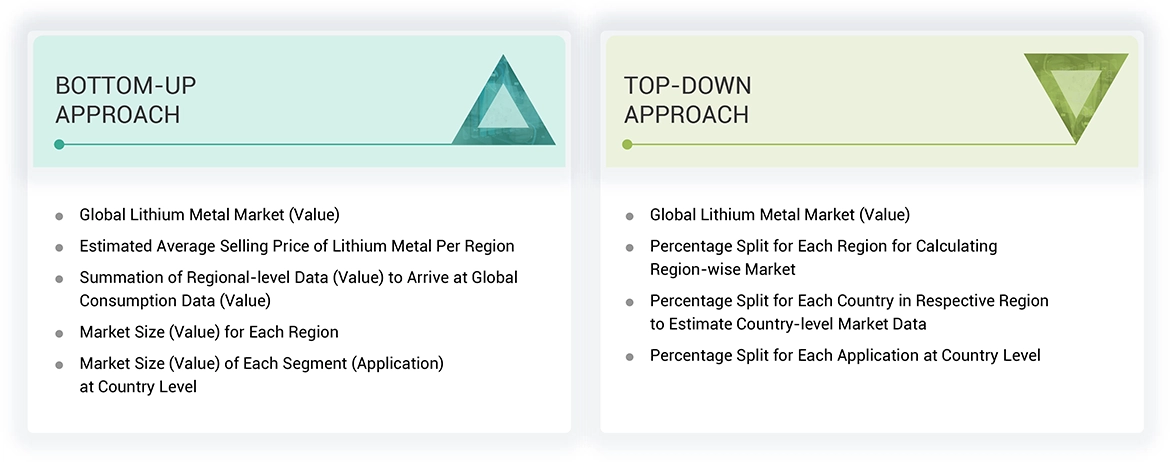The study involved four major activities in estimating the current market size of lithium metal. Exhaustive secondary research was done to collect information on the market, peer, and parent markets. The next step was to validate these findings, assumptions, and sizes with industry experts across the value chain of lithium metal through primary research. Both top-down and bottom-up approaches were employed to estimate the total market size. After that, market breakdown and data triangulation were used to estimate the size of the segments and sub-segments of the market.
Secondary Research
The research methodology used to estimate and forecast the access control market begins with capturing data on the revenues of key vendors in the market through secondary research. In the secondary research process, various secondary sources, such as Hoovers, Bloomberg BusinessWeek, Factiva, World Bank, and Industry Journals, were referred to for identifying and collecting information for this study. These secondary sources included annual reports, press releases & investor presentations of companies; white papers; certified publications; articles by recognized authors; notifications by regulatory bodies; trade directories; and databases. Vendor offerings have also been taken into consideration to determine market segmentation.
Primary Research
The lithium metal market comprises several stakeholders in the supply chain, such as manufacturers, suppliers, traders, associations, and regulatory organizations. The demand side of this market is characterized by the development of lithium metal batteries, alloys making, intermediates in the pharmaceutical industry, and other applications. Various primary sources from the supply and demand sides of the market were interviewed to obtain qualitative and quantitative information. Following is the breakdown of the primary respondents:

To know about the assumptions considered for the study, download the pdf brochure
Market Size Estimation
The top-down and bottom-up approaches were used to estimate and validate the total size of the lithium metal market. These methods were also used extensively to determine the market size of various sub-segments in the market. The research methodology used to estimate the market size included the following:
-
The key players were identified through extensive primary and secondary research.
-
The value chain and market size of the lithium metal market, in terms of value, were determined through primary and secondary research.
-
All percentage shares, splits, and breakdowns were determined using secondary sources and verified through primary sources.
-
All possible parameters that affect the market covered in this research study were accounted for, viewed in extensive detail, verified through primary research, and analyzed to obtain the final quantitative and qualitative data.
-
The research included the study of reports, reviews, and newsletters of top market players, along with extensive interviews for opinions from key leaders, such as CEOs, directors, and marketing executives.

Data Triangulation
The market was split into several segments and sub-segments after arriving at the overall market size using the market size estimation processes as explained above. To complete the overall market engineering process and arrive at the exact statistics of each market segment and subsegment, data triangulation and market breakdown procedures were employed, wherever applicable. The market size was calculated globally by summing up the country-level and regional-level data.
Market Definition
Lithium metal refers to the pure elemental form of lithium, which is a highly reactive alkali metal. It is the lightest metal and has a silvery-white appearance. Lithium metal has a low density and is highly malleable, meaning it can be easily shaped or molded. It is also an excellent conductor of heat and electricity. It is widely used in electronic devices like wristwatches, smoke detectors, children’s toys and key fobs. It is highly desirable for battery applications due to its high energy density and low weight.
Stakeholders
-
Lithium metal Manufacturers
-
Traders, Distributors, and Suppliers of Lithium metal products.
-
Manufacturers of Lithium metal batteries, Alloy making companies, and pharmaceutical companies.
-
Associations and Industrial Bodies such as the International Air Transport Association (IATA), American Chemical Society (ACS), Institute of Electrical and Electronics Engineers (IEEE), United States Environmental Protection Agency (EPA), International Lithium Association (ILA) and Others
-
Contract Manufacturing Organizations (CMOs)
-
NGOs, Governments, Investment Banks, Venture Capitalists, and Private Equity Firms
Report Objectives
-
To define, describe, and forecast the size of the global lithium metal market in terms of volume and value
-
To provide detailed information regarding the key factors, such as drivers, restraints, opportunities, and industry-specific challenges, influencing the growth of the global lithium metal market
-
To analyze and forecast the size of various segments (source and application) of the lithium metal market based on four major regions—North America, Asia Pacific, Europe, Rest of the World—along with key countries in each of these regions
-
To analyze recent developments and competitive strategies, such as expansions, new product developments, agreements, and acquisitions, to draw the competitive landscape of the market
-
To strategically profile the key players in the market and comprehensively analyze their core competencies



Growth opportunities and latent adjacency in Lithium Metal Market